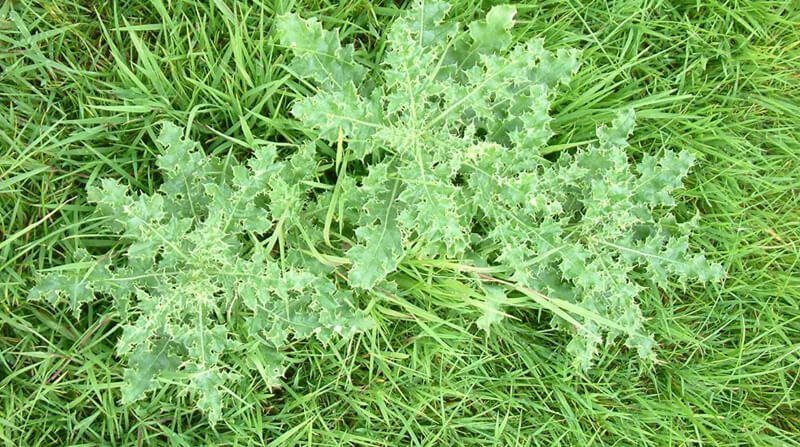The are several species of Thistles that often plague gardeners and farmers all over the UK but most can’t tolerate regular mowing.
However, there are two types of Thistle that can inhabit lawns;
- Creeping Thistle
- Dwarf Thistle
The good news is, they’re both very easy to control. In this article, I’ll show you how to identify the two Thistles, how to remove them and how to prevent these weeds from growing back.
Thistles in a Nutshell
Here’s what you need to know about Thistles;
Appearance
The treatment of Thistles in a lawn is the same for both species. That said, it’s handy to be able to identify one from the other.
Creeping Thistles
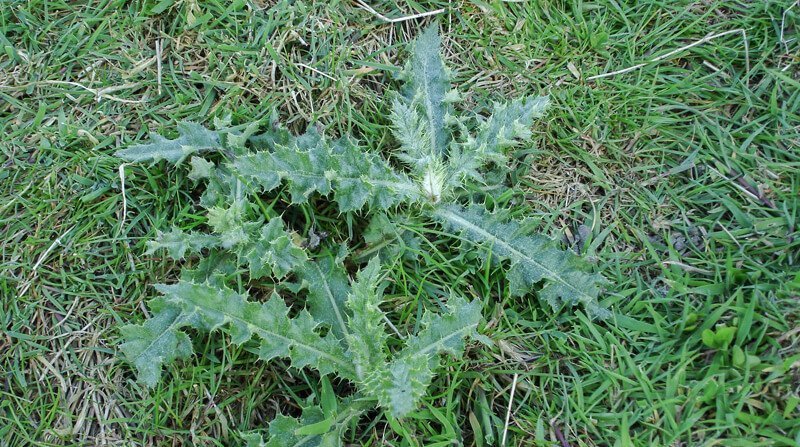
The most common species of Thistle found in lawns.
Creeping Thistle or Cirsium arvense grows erect, spineless stems from a creeping rootstock. These stems produce wavy leaves that look similar to the leaves of Dandelions, except they’re spiky and sometimes have hairs on the underside.
The flowers, which are rarely seen in lawns due to mowing are Lilac in colour and are borne in clusters. They bloom between June and September and give off a distinct smell of honey.
Dwarf Thistles
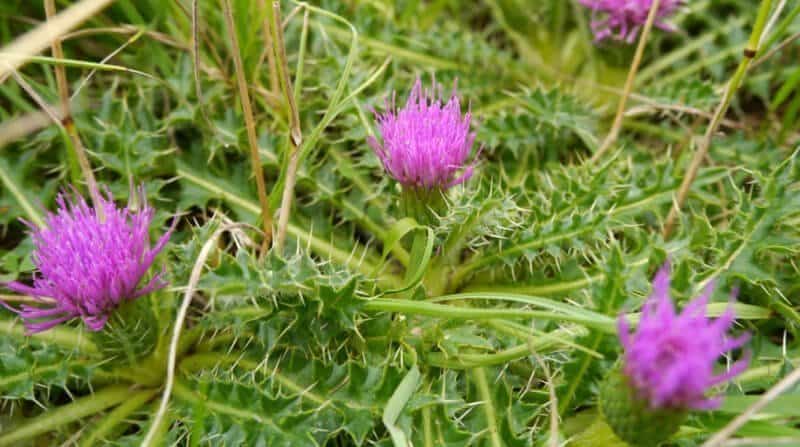
Dwarf Thistle or Cirsium acaule isn’t as common but it can make an appearance from time to time.
Like Creeping Thistles, the leaves are similar to Dandelions and spiky but they’re pretty much hairless. Instead of growing on stems, Dwarf Thistle grows a rosette of leaves.
Growing from the centre of this rosette of leaves is the reddish purple flower which blooms between June and September.
A Perennial Weed
Thistles are perennial weeds that grow back year after year forming deeper and deeper roots as it establishes itself.
They don’t tolerate mowing well though and this on its own can be enough to get rid of them.
Preferred Habitat
Like most weeds, Thistles can grow in most soil types but they do excel in certain conditions;
- Creeping Thistle grows best in newly sown lawns
- Dwarf Thistle prefers chalky soils
How to Remove Thistles From Your Lawn
Like any weed, it’s best to remove Thistles as soon as you see them before they get a chance to root deeply. If you leave it, it will become tougher to get rid of.
Removing them By Hand
If you spot them early, removing them by hand is easy. Either pull them out by hand or use a hand fork another type of weeding tool.
Also, regular mowing can be enough to eradicate them, especially in established lawns.
Use a Spot Spray Weedkiller For Lawns
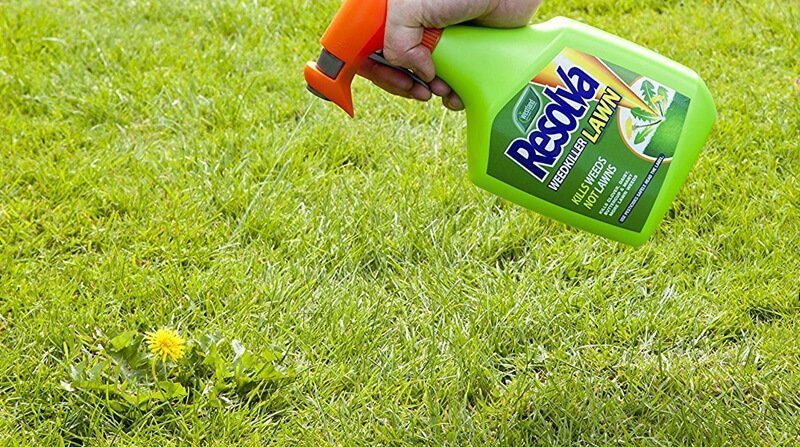
If the weed persists after digging them out, or the idea of digging weeds up sounds like too much hard work, you can give them a blast with a spot spray weed killer for lawns, such as Scotts Weedol Lawn Weedkiller Spot Spray or Resolva Spot Spray Weedkiller for Lawns.
However, if you’ve got a bigger problem and it’s taken over your lawn along with other types of weeds like Daisies or Clover, for example, you’ll need to treat the whole lawn.
Use a Weedkiller Concentrate to Treat the Whole Lawn
It’s rare that your lawn will be taken over by just one type of weed. Usually, if there’s a lot of one type of weed, there will be plenty of others too.
Spot spraying in a situation like this is futile. Treating the whole lawn with a selective weedkiller concentrate is the only option.
Products like Weedol Lawn Weedkiller Concentrate are designed to be diluted in water and applied using either a knapsack sprayer or watering can.
When using a weedkiller concentrate, be sure to read the instructions and mix the concentrate accurately.
If you make it too weak, you’ll not kill the weeds. Make it too strong and you could kill the grass as well as the weeds.
Read: Choosing and Using the Best Weedkiller for Lawns
How to Prevent Thistles From Growing in Your Lawn
Good lawn care practices will prevent Thistles and other weeds from growing back.
Like I always say, weeds are a symptom of other problems as a result of poor lawn care practices.
If you follow these lawn care treatments, your lawn will be so thick and lush, there will be no room for weeds like Thistle to grow.
Cut the Grass Regularly

If you do nothing else to your lawn, just cut the grass regularly.
This is by far the most important part of lawn care.
Mowing the lawn regularly prevents the grass from growing too tall. Grass has to grow, and if it can’t grow upwards it will be forced to grow sideways, creating new shoot and new grass leaves. This is what creates a thick, dense, lush lawn.
If you cut the grass every 6 weeks with a rusty old lawnmower you’ll have patchy grass that goes brown every time you cut it. This is the type of environment that weeds thrive in.
So cut the grass at least every 10 days between April and September.
Read: How to Mow the Lawn Like a Pro: Everything You mowShould Know About Grass Cutting
Remove Excess Thatch by Scarifying
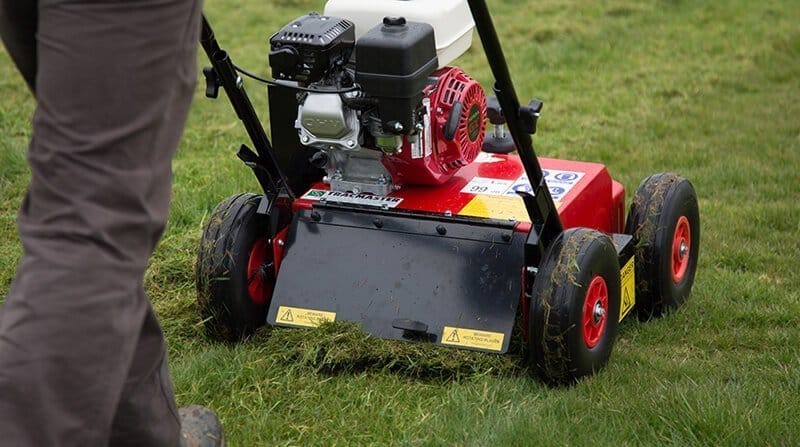
Lawn thatch is a layer of dead and living organic material that lies between the grass and soil. It consists of old and new grass roots as well as other stuff.
Some thatch is a good thing because it protects the crown of the grass plant. Too much, on the other hand, will prevent water, air and nutrients from penetrating the soil. When these nutrients can’t penetrate the soil, the roots of the grass can’t absorb them so are unable to produce food and grow.
And where grass can’t grow, weeds take over.
Scarification is the process of removing excess thatch (usually in the autumn) which opens the soil up so air, water and nutrients can penetrate it and the grass can consume them and grow strong.
Read: Lawn Scarification: Why, When and How to Scarify Your Lawn (The Ultimate Guide)
Also Read: Choosing the Right Scarifier: My Top Picks and Buyers Guide
Relieve Soil Compaction by Aerating
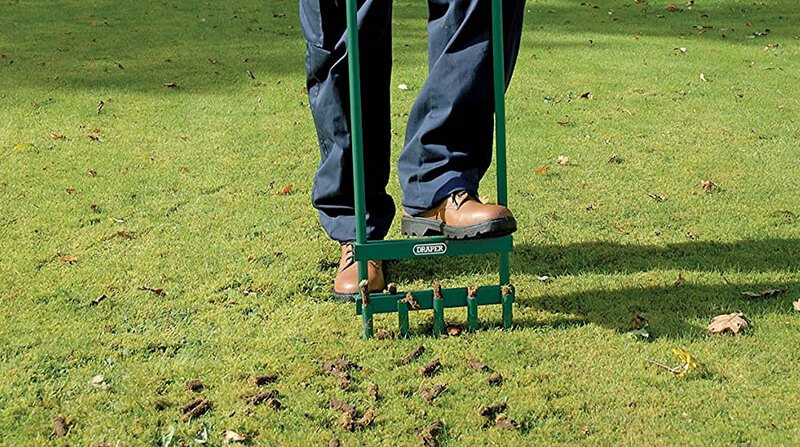
Compacted soil means nutrient-deficient soil.
Soil compaction occurs when the lawn is used often. This might be the kids playing on it or the dog using it to do their business or using a certain part of the lawn regularly. Goalposts, washing lines or where the postman walks to get to your front door are all good examples.
The particles of soil beneath the grass get pressed together over time which squeezes out air and water. It also prevents air, water and other nutrients from getting into the soil so the grass can’t consume them, produce food and grow.
Again, the result is a patchy lawn, sometimes with complete bald spots of hard soil.
Weeds love this kind of environment!
Aeration involves either spiking the surface of the lawn (in the spring) or removing cores of turf via hollow-tining (in the autumn).
This creates space in the soil to allow water, oxygen and nutrients to penetrate. It also relaxes the soil, making it easier for roots to grow and establish themselves, resulting in a healthy lawn full of healthy grass.
Read: Lawn Aeration: Everything You Need to Know About Aerating Your Lawn (The Ultimate Guide)
Fertilise Your Lawn at Least Once a Year
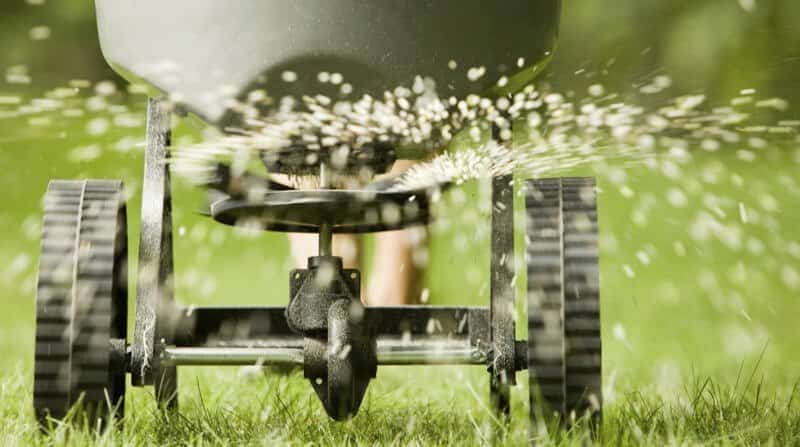
Grass consumes nutrients from the soil and uses them to produce food and grow. Primarily Nitrogen, Potassium and Phosphate.
Every time you cut the grass you take some of these nutrients away. So, it’s a good idea to top them back up every so often.
You can buy all kinds of fertilisers which can be applied at different times of the year. The type of lawn you have and your willingness to spend time and money will dictate what type and how often you fertilise your lawn.
That said, apply a good quality, slow-release fertiliser at least once a year. It won’t break the bank, it’s easy to do and your lawn will look a lot better than if you didn’t.
Read: Lawn Fertiliser: What, Why, When and How to Feed Your Lawn
Also Read: Lawn Feed Reviews: The Best Products From the Biggest Brands
Now It’s Up to You
Thistles are very simple to kill and remove but as I have said, that’s not even half the battle.
Lawn weeds are usually a symptom of other problems like excess lawn thatch, compacted, nutrient-deficient soil and infrequent mowing.
If you fix these issues (and it’s not difficult, just a bit of basic knowledge and the willingness to actually do it) your lawn will be healthier than it ever has been and you’ll be rewarded with a patch of grass that looks spectacular.
